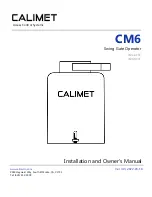
6
34
12
OPEN-A
STOP
FSW
-TX FSW
LAMP
24V
ON
230V
L
N
J5
BA
TT
J1
J2
DS1
SET UP
OPEN
LD6
LD5
OPEN B
OPEN A
LD3
LD2
J3
J4
J5
J7
J8
J12
LD4
LD1
ENGLISH
7.2. Fitting on the door
1) Assemble the fitting with the carriage rod (Fig. 17). Place
the fitting on the door in order that the through hole of the
release cable is directed toward the left side of the door
(ref.
Fig. 18).
2) Close the door and take the carriage to it.
3) Place the fitting on the door centered to the center line of
it.
4) Check if the distance between centres of the securing
holes of the front fitting and of the fitting on the door does
not exceed 20 cm (Fig. 18). For a correct operation of the
automated system, we recommend you to avoid arm
inclination over 30° with respect to the sliding guide. If a
curved arm for sectional door (optional) is used, perform the
assembly with the straight arm of the carriage as shown in
Fig. 19. To improve the efficiency of the anti-crushing system,
we recommend you to secure the fitting on the sectional
door as down as possible without exceeding however the
distance of 40 cm from the front fitting of the operator. (Fig.
19)
5) Mark, drill and secure the fitting to the door using the screws
(ref.
Fig. 18) that are
NOT
standard supplied.
7.3. Operator
After having assembled the rear fitting with the sliding guide
and after having completed the installation of the sliding guide,
you can mount the operator:
1) Keep the operator inclined by 15°/20° (Fig. 21), insert the
gearmotor shaft into the coupling in the rear fitting of the
sliding guide and move the fins (Fig. 20 rif.
) close to the
seats on the bottom of the operator (Fig. 20 rif.
).
2) Turn the operator in the direction given in Fig. 21 until
reaching the position shown in Fig. 22, then fit the pin into
the hole of the rear fitting (Fig. 22 rif.
).
7.4. Release device of the automated system
1) Define the height of the release knob, taking into
consideration that it must not exceed a height of 180 cm
off the ground, then cut the rope in excess.
2) Make a knot at the end of the rope and assemble the release
handle (Fig. 23).
3) Pull downwards the release handle and check if the door
can be moved manually (Fig. 23).
4) To lock again the operator, pull the release handle
horizontally to the door (Fig. 24). Check if, when the handle
is released, the LOCK window, which is located under the
carriage, is red. Move the door manually until reaching again
the coupling point of the carriage.
Prevent people, animals or objects from standing within
the movement area of the door during the release
operation.
7.5. External release
If the automated system has an external release, you need to
complete the installation you have already begun (see par.
6.3.):
1) Cut the cable sheath to measure (Fig. 25 ref. A).
2) Route the cable into the sheath and through its relevant
eyelet of the fitting on the door (Fig. 25 ref. B).
3) Cut the cable to measure and assemble it with the internal
lever of the release handle (Fig. 25 ref. C).
8. E700HS CONTROL BOARD
8.1. Technical specifications and components
Voltage power supply (V ~ / Hz.)
230 / 50
Power supply to accessories (Vdc.)
24
Accessories max. load (mA.)
200
Operating ambient temperature (°C)
-20 / +55
Rapid connector
For XF433 / XF868 receiving
cards and battery module
Operating logics
Automatic/Semiautomatic
Terminal board connections
Open/Stop/Safety devices/ Fail
Safe/ Flashing lamp 24 Vdc.
Courtesy lamp timing (min.)
2
J1
Low-voltage terminal board for inputs/accessories
J2
Rapid connector for XF433 or XF868 receivers
J3
230V power supply input terminal board
J4
Transformer primary connector
J5
Courtesy lamp terminal board
J7
Transformer secondary connector
J8
Motor output connector
J12
Battery module connector
OPEN A
Radio signal programming push-button
OPEN B
Radio signal programming push-button
OPEN
OPEN push-button
SETUP
SET UP push-button
DS1
Programming dip-switch
LD1
OPEN input signalling LED
LD2
STOP input signalling LED
LD3
FSW input signalling LED
LD4
SET UP cycle signalling LED
LD5
OPEN A radio channel memory-storing signalling LED
LD6
OPEN B radio channel memory-storing signalling LED
Summary of Contents for D700HS
Page 1: ...D700HS...
Page 15: ...8 5 6 7 4...
Page 16: ...15 14 13 12 11 10 A B C 9...
Page 17: ...23 22 21 20 15 20 19 18 17 16...
Page 18: ...28 OPEN A ALTRE SICUREZZE STOP 27 26 25 24 A C B...
Page 19: ...35 34 31 32 33 30 OPEN B OPEN A RADIO SET UP 29...
Page 20: ...43 2 sec 5 sec 42 41 8 sec 40 1 sec 38 39 2 sec 5 sec 37 8 sec 36 1 sec...
Page 21: ...50 49 51 4 sec 2 sec 5 sec 48 5 sec 47 2 sec 5 sec 46 44 45 5 sec 4 sec...








































